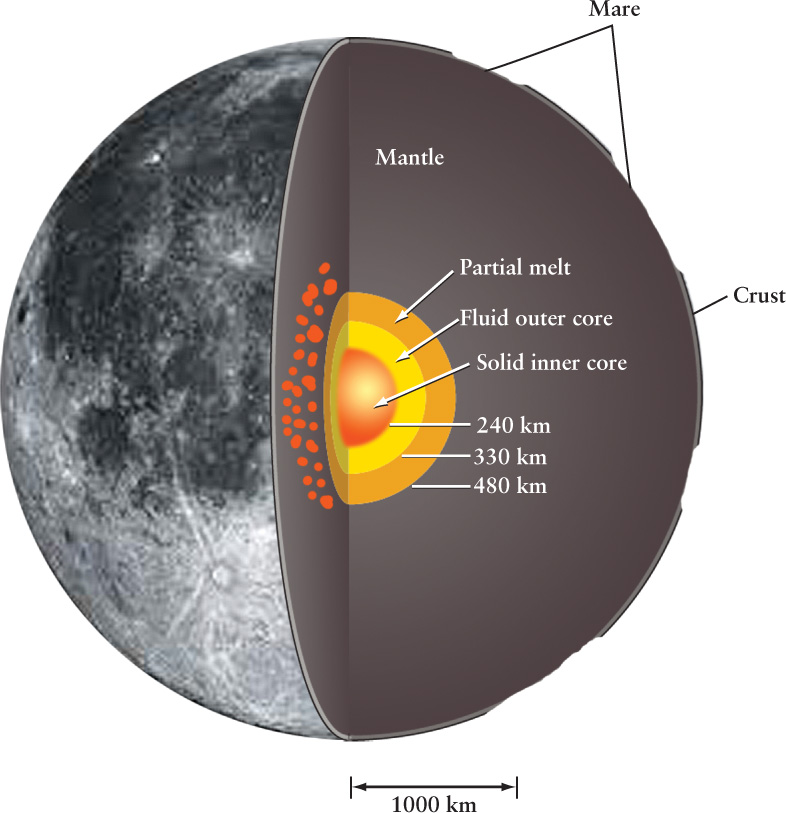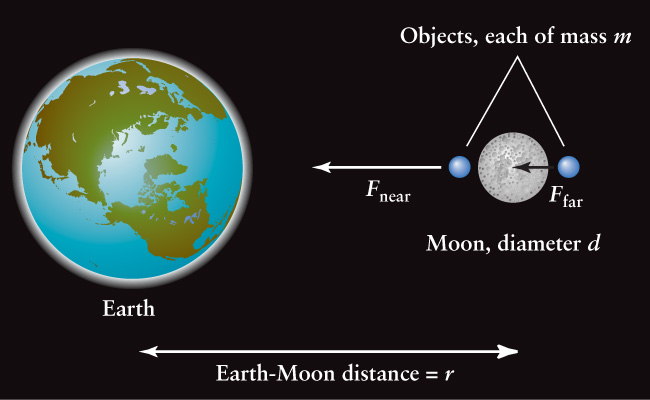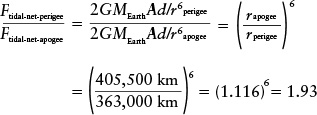10-3 The Moon has no global magnetic field but has a small molten core
Compared to earthquakes, moonquakes are few and feeble—but they reveal key aspects of the Moons interior
We saw in Section 7-6 and Section 7-7 that a small planet or satellite will have little remaining internal heat, and hence is likely to have a mostly solid interior. Because it lacks substantial amounts of moving molten material in its interior, a small world is unlikely to generate a global magnetic field. However, a small world can still have a small molten core, which is just what has been found for the Moon.
No Global Magnetic Field
The Moon landings gave scientists an unprecedented opportunity to explore an alien world. The Apollo spacecraft were therefore packed with an assortment of apparatus that the astronauts deployed around the landing sites (see Figure 10-9). For example, all the missions carried magnetometers, which confirmed that the present-day Moon has no global magnetic field. However, careful magnetic measurements of lunar rocks returned by the Apollo astronauts indicated that the Moon did have a weak magnetic field when the rocks solidified billions of years ago. Hence, the Moon must originally have had a small, molten, iron-rich core. (We saw in Section 7-7 that Earth’s magnetic field is generated by fluid motions in its interior.)
The Moon’s Interior
The Apollo astronauts also set up four seismometers on the Moon’s surface, which made it possible for scientists to investigate the Moon’s interior using seismic waves just as is done for Earth (Section 9-2). It was found that the Moon exhibits far less seismic activity than Earth. Roughly 3000 moonquakes were detected per year, whereas a similar seismometer on Earth would record hundreds of thousands of earthquakes per year. Furthermore, typical moonquakes are very weak. A major terrestrial earthquake is in the range from 6 to 8 on the Richter scale, while a major moonquake measures 0.5 to 1.5 on that scale and would go unnoticed by a person standing near the epicenter.
Analysis of moonquakes reveals that the Moon has a thick mantle surrounding an iron-rich core (Figure 10-14). The Moon also has a crust with an average thickness of about 60 km on the Earth-facing side and up to 100 km on the far side. For comparison, the thickness of Earth’s crust ranges from 5 km under the oceans to about 70 km under major mountain ranges on the continents (see Table 9-3). This slightly lopsided distribution of mass between the near and far sides of the Moon helps to keep the Moon in synchronous rotation, so that we always see the same side of the Moon (see Section 4-8).

BOX 10-1 TOOLS OF THE ASTRONOMER’S TRADE
Calculating Tidal Forces
The gravitational force between any two objects decreases with increasing distance between the objects. This principle leads to a simple formula for estimating the tidal force that Earth exerts on parts of the Moon.
Consider two small objects, each of mass m, on opposite sides of the Moon. Because the two objects are at different distances from Earth’s center, Earth exerts different forces Fnear and Ffar on them (see the accompanying illustration). The consequence of this difference is that the two objects tend to pull away from each other and away from the center of the Moon (see Section 4-8, especially Figure 4-26). The tidal force on these two objects, which is the force that tends to pull them apart, is the difference between the forces on the individual objects:
Ftidal = Fnear - Ffar
Both Fnear and Ffar are inversely proportional to the square of the distance from Earth (see Section 4-7). If this distance were doubled, both forces would decrease to ½2 = ¼ of their original values. But the tidal force Ftidal, which is the difference between these two forces, decreases even more rapidly with distance: It is inversely proportional to the cube of the distance from Earth to the Moon. That is, doubling the Earth-Moon distance decreases the tidal force to ½3 = ⅛ of its original value. If we use the symbols MEarth for Earth’s mass (5.974 × 1024 kg), d for the Moon’s diameter, r for the center-to-center distance from Earth to the Moon, and G for the universal constant of gravitation (6.67 × 10−11 newton m2/kg2), the tidal force is given approximately by the formula

EXAMPLE: Calculate the tidal force for two 1-kg lunar rocks at the locations shown in the figure.
Situation: We are asked to calculate a tidal force. We know the masses of Earth (MEarth) and of each of the two rocks (m = 1 kg). The Earth-Moon distance (r) and the diameter of the Moon (d, equal to the separation between the two rocks) are given in Table 10-1.

Tools: We use the equation given above for the tidal force Ftidal.
Answer: To use the given values in the equation, we must first convert the values for the average Earth-Moon distance r and the Moon’s diameter d from kilometers to meters:

The tidal force is then

Review: To put our result into perspective, let us compare it to the weight of a 1-kg rock on the Moon. The weight of an object is equal to its mass multiplied by the acceleration due to gravity (see Section 4-6). This acceleration is equal to 9.8 m/s2 on Earth, but is only 0.17 as great on the Moon. So, the weight of a 1-kg rock on the Moon is
0.17 × 1 kg × 9.8 m/s2 = 1.7 newtons
Thus, the tidal force on lunar rocks is much less than their weight, which is a good thing. If the tidal force (which tries to pull a rock away from the Moon’s center) were greater than the weight (which pulls it toward the Moon’s center), loose objects would levitate off the Moon’s surface and fly into space!
The tidal force of Earth on the Moon deforms the solid body of the Moon, so that it acquires tidal bulges on its near and far sides. The mass of each bulge must be proportional to the tidal force that lifts lunar material away from the Moon’s center. So, the above formula tells us that the mass of each bulge is inversely proportional to the cube of the Earth-Moon distance r:

(Determining the value of the constant A requires knowing how easily the Moon deforms, which is a complicated problem beyond our scope.) We can then use our formula for the tidal force Ftidal to tell us the net tidal force on the Moon. To make this calculation, we think of the objects of mass m on opposite sides of the Moon as being the tidal bulges. So, we substitute mβulge for m in the tidal force formula

Thus, the net tidal force on the Moon is inversely proportional to the sixth power of the Earth-Moon distance. Even a small decrease in this distance can cause a substantial increase in the net tidal force.
EXAMPLE: Compare the net tidal force on the Moon at perigee (when it is closest to Earth) and at apogee (when it is farthest away).
Situation: We are asked to compare the tidal forces on the Moon at two different distances from Earth. To make this comparison, we will find the ratio of the tidal force at perigee to the tidal force at apogee.
Tools: We use the equation given above for the net tidal force on the Moon.
Answer: The Earth-Moon distances at perigee and apogee are given in Table 10-1. If we take the ratio of the tidal forces at these two distances, the constants (including the unknown quantity A) cancel out:

Review: Our result tells us that the net tidal force at perigee is 1.93 times as great (that is, almost double) as at apogee. Tidal forces on the Moon help create the stresses that generate moonquakes, so it is not surprising that these quakes are more frequent at perigee than at apogee.
More than 30 years after the original Apollo data shed light on the Moon’s internal structure, the seismic data were reanalyzed in 2011 and revealed a molten core. Like Earth, the Moon’s iron-rich core has a solid inner core, surrounded by a liquid outer core. However, the liquid core is too small for the convection that is needed to generate a global magnetic field.
On the whole, seismic waves indicate that the Moon’s interior is much more rigid and less fluid than the interior of Earth. Plate tectonics requires that there be fluid motion just below a planet’s surface, so it is not surprising that there is no evidence for plate tectonics on the lunar surface.
The Origin of Moonquakes
Earthquakes tend to occur at the boundaries between tectonic plates, where plates move past each other, collide, or undergo subduction (see Figure 9-14). But there are no plate motions on the Moon. What, then, causes moonquakes? The answer turns out to be Earth’s tidal forces. Just as the tidal forces of the Sun and Moon deform Earth’s oceans and give rise to ocean tides (see Figure 4-26), Earth’s tidal forces deform the solid body of the Moon. The amount of the deformation changes as the Moon moves around its elliptical orbit and the Earth-Moon distance varies. As a result, the body of the Moon flexes slightly, triggering moonquakes. The tidal stresses are greatest when the Moon is nearest Earth—that is, at perigee (see Section 3-5)—which is just when the Apollo seismometers reported the most moonquakes. Box 10-1 has more information about how the tidal stresses on the Moon depend on its distance from Earth.
Without tectonics, and without the erosion caused by an atmosphere or oceans, the only changes occurring today on the lunar surface are those due to meteoroid impacts. These impacts were also monitored by the seismometers left on the Moon by the Apollo astronauts. These devices, which remained in operation for several years, were sensitive enough to detect a hit by a grapefruit-sized meteoroid anywhere on the lunar surface. The data show that every year the Moon is struck by 80 to 150 meteoroids having masses between 0.1 and 1000 kg (roughly ¼ lb to 1 ton).
CONCEPT CHECK 10-3
Does every world with a liquid iron-rich core contain a magnetic dynamo?
No. The Moon’s liquid iron-rich core is too small for the convection that creates a magnetic dynamo. This is why the Moon today has no global magnetic field.